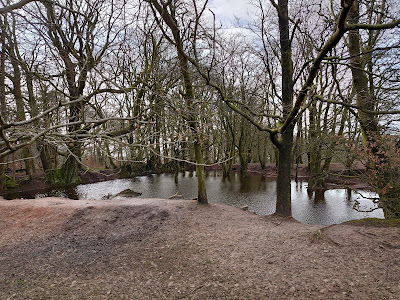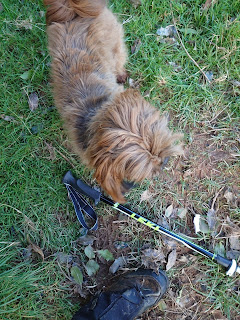Leaving Gurney Slade it was crisp with overnight frost and after the wet grey days before it was a joy to turn the corner and see this house lit by the morning sun
I'd revised the route in light of the previous days' experiences and followed the road for much of the morning. If you've read Simon Winchester's book The Map that Changed the World he says "...the roads on this part of Somerset were atrocious, thick with mud and as rough as the surface of the moon" - can't disagree too much with that..
Navigation on this trip has been more of a challenge than the SWCP, not only because of the lack of coast but also the signage on some of the paths is a bit sporadic. Nevertheless I can't blame that for my mis-routing in Midsomer Norton. I was sure I'd thought (incorrectly) that I'd been wrong only to discover I'd been right to start with (!) so had a circuitous route through the town. Consequently I saw nothing of the town centre and my planned coffee stop never happened.
The name Midsomer refers to the river Somer and has no connection with the TV series, except that the writer thought it sounded quintessentially English. It used to have significant industries of coal mining and packaging (the largest producer of recyclable plastic bags in Europe until 2011). These have largely closed or moved elsewhere and there are business parks now on the outskirts. The town used to have two railway stations, on the GWR line and the Somerset & Dorset line - the latter closed in 1966 but is now being restored by the Somerset & Dorset Railway Heritage Trust.
However the best lines to come out of Midsomer are from the Wurzels (a Scrumpy & Western band). Who can forget "The Sheriff of Midsomer Norton", not to mention the chart-topping hit "The Combine Harvester". Sedge Moore, the bass player, was born here. More illustriously, maybe, Midsomer was immortalised in Flanders & Swan in The Slow Train ("No more will I go to Blandford Forum and Mortehoe, on the slow train from Midsomer Norton and Munby Road"). In a literary vein Roald Dahl used to sell kerosene door-to-door from his motor tanker and Evelyn Waugh spent boyhood summers here with his aunts.
Being on the edge of the Levels the town used to flood regularly, until 1977 when a relief tunnel was completed, running under the high street. There is a lovely Riverside Walk with very artistic fencing to celebrate it put up by the local council - I briefly chatted to a local who'd been out gathering wild garlic for his breakfast.The river was regenerated with new plant life during the summer of 2012 in a bid to improve the aesthetics of the town centre
I had a mix of road and paths after that and managed to go completely wrong, despite having a paper map and the OS map on my phone. Attention to detail 'Nul points'. Still the recovery route took me across a field where the sheep mistakenly greeted me as their provider: these pics are for Deb
Also through the village of Tunley and much needed lunch at the King William.
Somewhat fortuitous since there hadn't been anywhere on my original route. From there I came back onto the Limestone Link, an attractive riverside ramble alongside the Cam Brook and although it was pretty soggy it was a tranquil valley that I'd like to do again.
I saw some kind of hawk (too large for a kestrel, too small for a buzzard) and listened to woodpeckers, which I guess means the trees have dried out enough for it to be heard.
Leaving it for the climb up in to Combe Hay you get some idea of the valley looking back
From there up to South Stoke (renamed from Southstoke by the parish council in 2004) which is also on the old Somerset Coal Canal and just over the hill from Bath. Again a well presented collection of old buildings with a splendid view out over the valley
I was keen too make it on to Bath so neglected to call in to the Packhorse Inn. Dating from 1498 it was bought as a resource of community interest, refurbished and reopened in 2018. Definitely one for a visit later...
From there it's just over the hill and down into Bath. I'd been keen to get a photo of Bath from up here but had to do it from the middle of the road and dodge the traffic
You can just make out the Royal Terrace. It was a beautiful end to a challenging walk, with more than a few mis-routings and some cold dank weather to dampen my enthusiasm. I'm really pleased to have done it and linked Minehead to Bath - now I just need to complete the Cotswold Way, the Severn Way, the Staffordshire Way, the Peak District National Park and the Pennine Way and I'll have made it to Scotland. Seemples.



























































